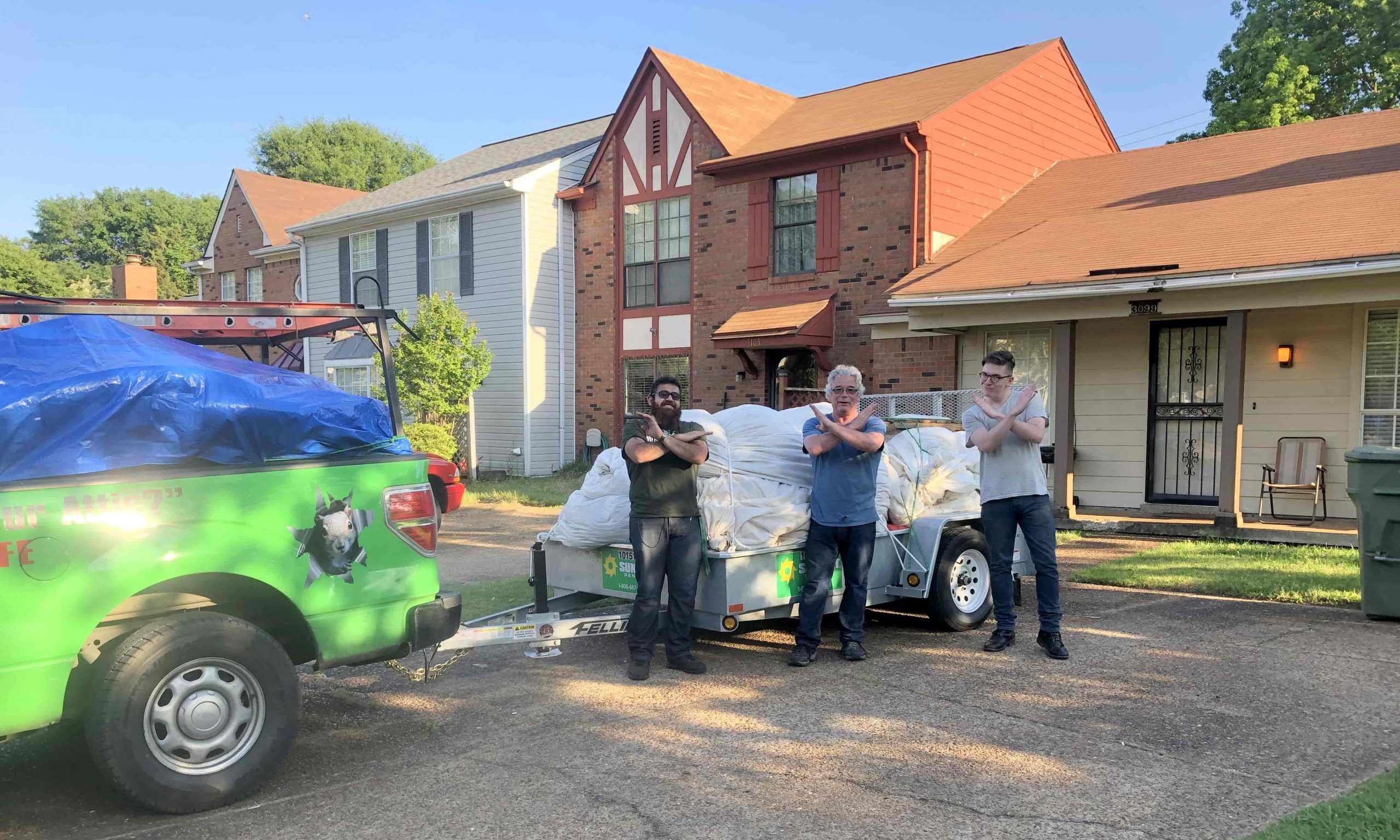
Call for Your Exclusive Wildlife Inspection Report.®
Opossum Removal
Opossums are one of the most unique animals in North America; they are the only marsupials in the region, meaning that their young develop in an external pouch, just like kangaroos. Although they are not the most destructive creatures, they are quite capable of causing a mess, especially if they access your property.
These nuisance pests are primarily docile and nocturnal. They are also opportunistic feeders and asides from eating fruit, grains, and insects, they will also eat compost piles, garbage cans, and pet food. For many homeowners around the Oklahoma City area, here are some of the most common problems caused by opossums:
- Opossum residing in the attic
- Opossum living under the porch, shed, or deck
- Turning over garbage cans, pet food, and eating from it
- Defecating in the yard or swimming pool
- Risk of diseases, including tuberculosis, leptospirosis, tularemia, coccidiosis, toxoplasmosis, and Chagas disease
- The terrible odor from a decomposing opossum carcass.
At Wildlife X Team Oklahoma City, we can help you deal with your opossum infestation.
Opossum Removal Process
Here’s how professionals at Wildlife X Team Oklahoma City go about opossum removal:
Inspection
The first stage of opossum removal is understanding their activity in your yard. Opossums are primarily attracted to a property by two major things: food and shelter. During this stage, the goal is to find out what’s attracting them to your property. Does there seem to be high activity around your trash cans at night? Or do you hear screeching and hissing sound coming from the attic?
Furthermore, looking for signs of infestations such as scattered trash, droppings, and more, can help indicate their presence. If the opossum is residing in your property, this stage will help you identify where it’s nesting.
Opossums are tractable creatures and this makes them easy to remove. In the face of threat, they are likely to play ‘possum’ or dead. When handling an opossum, it’s important to wear hand gloves to avoid the transmission of diseases.
Adult opossums in the attic can easily be caught with a snare pole. However, the attic should be properly checked for baby possums since nursing mothers are the regular occupants of attics.
Trapping can also be used to capture and relocate opossums. However, remember that trapping is subject to state laws so make sure to check with your local wildlife authority. Trapping is an art that requires an adept understanding of opossum behavior. At Wildlife X Team Oklahoma City, we apply our expertise to help you come up with an effective trapping strategy.
How to Effectively Trap Opossums
Opossums are generally not very destructive, but they can be a big nuisance. That’s especially true if the whole family makes their home somewhere in or around your home. At Wildlife X Team Oklahoma City, we have seen it all when it comes to opossums.
The most common thing we see when it comes to opossums is the mess they create. If an opossum makes its home on your property, you’re likely to find trash scattered around as well as droppings and other food scraps. This can get even worse if the opossum somehow finds its way inside your home.
The best way to deal with an opossum invading your space is to trap the animal and remove it to a distant location. However, this isn’t as simple as just placing a trap on the ground and waiting for the animal. There are some techniques and tactics involved that will give you the best odds of success.
Where to Place an Opossum Trap
The first step to trapping an opossum is to determine where the animal is spending its time on your property. At Wildlife X Team Oklahoma City, we recommend doing this during daylight hours because this is when the animal will be less active.
The best place to set up your trap will be just outside the opossum den. This gives you the best odds of catching the animal as it comes and goes. If you can’t find the den or you know that it’s outside of your property, the next best move is to place the trap in the area where you see the most evidence of the animal.
The Best Opossum Trap
Once you locate the opossum den, you can start thinking about how to trap the animal. At Wildlife X Team Oklahoma City, our top recommendation for opossum traps is a large steel cage trap with a single door. When we say large, we’re talking about a trap that’s around 3 feet long and 1 foot high.
These traps are live traps, meaning the animal will not be harmed. They work using bait – when you set the trap, you place the bait inside it on top of the trigger plate. Once the animal enters the trap and steps on the trigger plate, the trap will close and the animal won’t be able to escape. We recommend these types of traps for most common household pests including raccoons, skunks, and foxes.
Best Opossum Bait
Once you’ve located the opossum den and you have your trap on hand, the next step is to bait and set the trap! Don’t get too excited just yet because this is where the real work comes in.
Choosing the right bait for an opossum is key to successfully trapping the animal. Now, it’s true that opossums are omnivores so they will eat almost anything – but that’s also part of the problem. Opossums eat the same foods as most other common pests. In our experience at Wildlife X Team Oklahoma City, the best opossum baits are apples, marshmallows, and sweet breads.
You will need to put some of the bait inside your trap on top of the trigger plate. We also recommend placing bait around the trap in a way that will lead the animal into the trap. This could mean making a trail of food from the den towards the trap, but it varies based on the situation.
How to Set Up an Opossum Trap
Once you have your bait, then it’s time to actually set the trap. Using the recommendations we already went over, place your steel cage trap around the opossum den or near the area where you see the most evidence of its presence.
Here’s another quick tip – when you place the trap, put a brick or rock on top of it so it won’t move once the animal is caged.
Place the bait on the trigger plate and make sure the door is set so it will close when triggered. Use some of your bait to create a trail towards the trap. Then it’s time to wait.
Opossums are nocturnal creatures, so we recommend setting the trap at dusk and checking it in the morning. You should not leave the trap open during the day because you might accidentally catch other animals.
Get Quote for Your Exclusive Wildlife Inspection Report.®


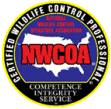
Decontamination & Repairs
After the opossum has been removed from either the attic or crawlspace, all their remnants like droppings, nesting materials, hairs, and other organic matters must be removed. The infected space must then be decontaminated with a special enzyme-based cleaner. Finally, all damaged materials, including insulation, chewed electric wires and more should be repaired.
Wildlife X Team Oklahoma City can help you develop an effective opossum removal strategy that will leave you opossum-free far into the future. If you live in the Oklahoma City area, contact us today!
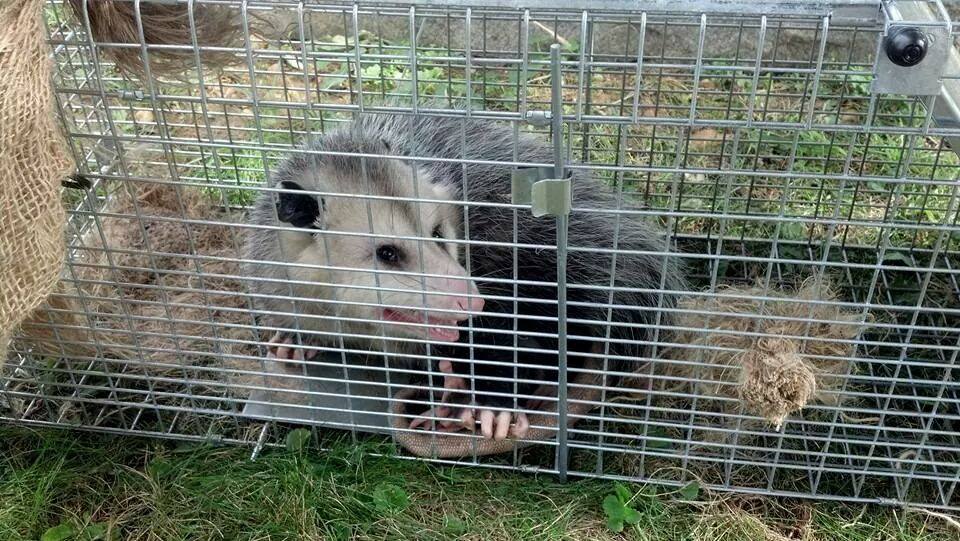
How to Get Opossums Out Of The Garbage
Opossums are one of the most fascinating wildlife in North America. First off, they are the only marsupial in the United States. What’s more, these mammals are immune to snake venom and rabies and can suspend their entire body’s weight with their tail. How cool is that?
Opossums are also known to play dead in the face of threat. Hence, they are docile creatures. However, they are highly notorious for the disturbance and damage they cause – especially under the cover of darkness. Visit wildlifehumane.org to learn more about opossum’s behavior.
Most notably, this nuisance wildlife loves to attack trash cans. Since opossums are omnivores, they can pretty much eat anything. Hence, their love for trash cans makes sense given the wide variety of food they can find there.
But having opossums around your property comes with several drawbacks. An opossum in your yard will continue its quest for food in your garden. And because they make a huge mess, they pollute your yard and devalue your property.
What’s more, sooner or later, an opossum wandering your yard will find its way into your house and may try to chew through walls, air ducts, or insulation. Their presence also exposes you and your family to the risk of several diseases including leptospirosis, tuberculosis, tularemia, and toxoplasmosis.
For these reasons, keeping opossums at bay is recommended by wildlife experts at Wildlife X Team Oklahoma City. And it starts by cutting off their food supply. If opossums are always raiding your garbage, this post explores what you can do to put an end to that.
Dispose of your trash properly.
Opossums have an exceptional sense of smell. They have 1,188 olfactory genes devoted to smell (compared to 396 for humans). Hence, they can smell food from a long distance out.
That’s why you need to dispose of your trash properly. Before tossing away your trash, tie it up properly in a garbage bag. This helps to reduce the foody scent it gives off. What’s more, ensure that leftovers are not overflowing your garbage.
And finally, do not let your trash sit in the garbage can for too long before transferring to the waste disposal service.
Get a metal garbage can.
You want to make your garbage can an impenetrable fortress. And the best way to do that is to use a metal can with a proper lid that locks in place. But why not plastic? You see, opossums and several other wild animals can chew through plastic garbage cans, but they can’t mess with metal cans.
Secure the garbage bin lid with clamps or a locking system.
Contrary to what you might think, opossums are pretty smart creatures. They can open up a closed lid – especially if it doesn’t lock properly.
If that’s the case with you, use a rope or bungee to tie the lid with the handle of the can. This helps to securely put the lid in place, making it impossible for opossums to open it.
Another thing you can do is place a heavy object on your trash can. This makes it difficult for opossums to open up your garbage can.
Apply repellents
As mentioned earlier, opossums have a great sense of smell. Hence, applying substances with scents opossums find offensive can help deter them. Common examples include ammonia, mothball, and cayenne pepper.
The problem with repellents is that they lose their effectiveness with time. Hence, they need to be re-applied to remain effective.
Trapping
In some instances, stubborn opossums will keep returning, looking for a way to break into your garbage. In these cases, trapping and relocation might be the best option. A live trap can be placed inside the can itself or close to it. Trapping opossums is no easy task. That’s why it’s recommended to involve wildlife removal experts. Wildlife X Team Oklahoma City is fully equipped to help bring an end to your opossum infestation. All you need to do is contact us today.
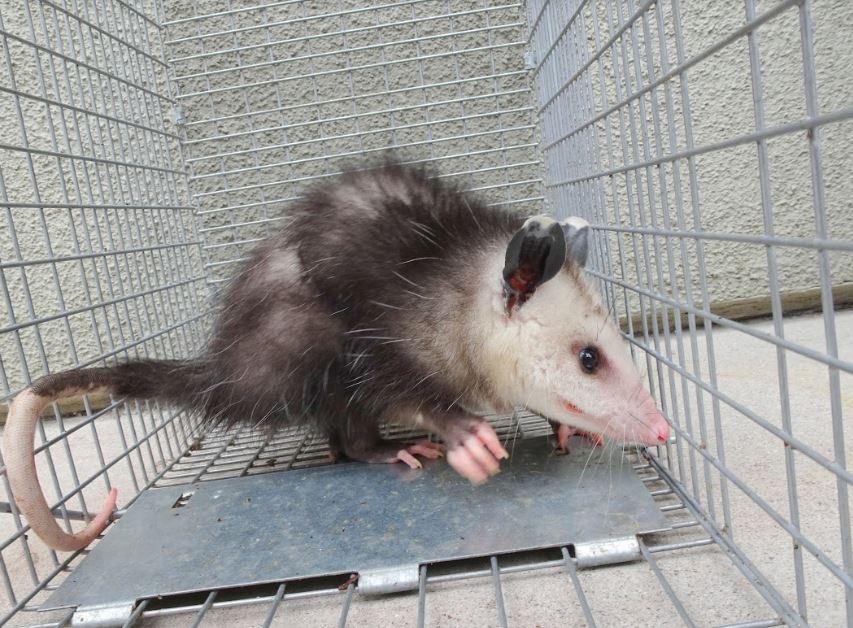
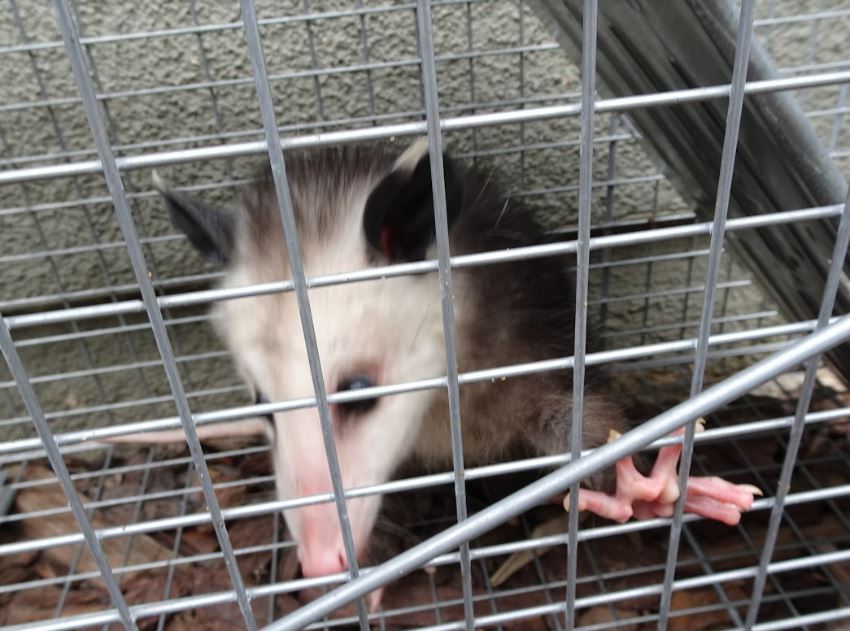
How To Get Rid of Opossums in Attic
Opossums are fascinating animals, noticeable for their “playing possum.” When you see a seemingly dead Opossum, don’t let it trick you, it may either be playing its natural defense mechanism or dead.
However, Opossums are very destructive/unhealthy risks, whether dead or alive. If you notice a Possum colony in your attic, it may be time to call our services.
In the pouch, you can easily distinguish opossums from other large rodents by their kangaroo-like nature of carrying their young ones. And since they are nocturnal, it makes their actions more destructive to man.
Some problems attached with Opossums include;
- Terrible odor
Whether “playing possum” or being dead, they give off a terrible odor. It is enough to make your house uninhabitable and repulsive.
- Thumping sounds
Running around in the attic can be a happy activity for Possums but a sad one for humans.
- Contamination of the environment
The areas habited by Possums are usually contaminated by their urines, droppings, or other pests they unknowingly carry.
- Germs and Diseases
Possums are carriers of diseases like; tuberculosis, leptospirosis, tularemia, coccidiosis, toxoplasmosis, and Chagas disease.
How to conclude a Possum suspicion
It is not enough to suspect any animal/wildlife to be a possum. Such suspicion can end up being a simple rodent. The best way to detect a possum infestation is to conduct an extensive inspection. Your inspection should also reveal the degree of infection.
Some signs of infestation include;
- The presence of their young ones
- Scratch, gnaw marks around the wood on the attic,
- Scattered trash or droppings
When discovering the cause of the infestation, isolate the material from the attic or anywhere around the house.
Removal of Opossum from Attic
If Possums find a way to your attic, it can be very disastrous through;
- Structural damage, and
- Health risks.
There are various ways to remove Possums, including;
- Traps
Although traps are usually harmful to the animals, they can be useful in scaring off or catching minor Possum invasions. Also, it ensures that the possum does not return to your attic.
However, you must conform to local laws before using traps or other non-human methods.
- Snare Poles
This is also an efficient option of removing possums from the attics. It ensures safe contact between the person and the disease-stricken animal.
- Exclusion technique
Ensure that the Possum is permanently disconnected from their food, water, or shelter source. This way, they will not hold much longer and choose to relocate.
- Repellents and pesticides
Pesticides and other natural repellents help prevent a Possum invasion. Although this is not effective as earlier methods, it can still come in as an excellent preventive measure.
- Scare them off
Possums can also be scared of the attic by frequent and intentional hostility. Ensure that you approach their settlements often, douse their homes with chemicals, and make the settlement uncomfortable.
Why my Attics
Attics are usually dark and unkempt spaces in the house. Their positioning close to the roof makes it easy for animals to steal through cracks or other openings. Since the attic affords them maximum space and privacy, they will consider settling there.
After Opossum removal, what next?
Removing the Opossum is not complete until you ensure there is no longer a presence or reminder of the infestation. This includes;
- Removing their droppings,
- Removing their young
- Washing and clearing of the attics
- Replacing all destroyed cables and utilities
- Sealing all Cracks or holes that aided their entry
- Repairing other damaged utilities and areas
Conclusion
Possums can be very deadly carriers of parasites and other germ-causing diseases. It is not advisable to DIY when dealing with Possums. Contact us for effective removal and control of possums in your surroundings.
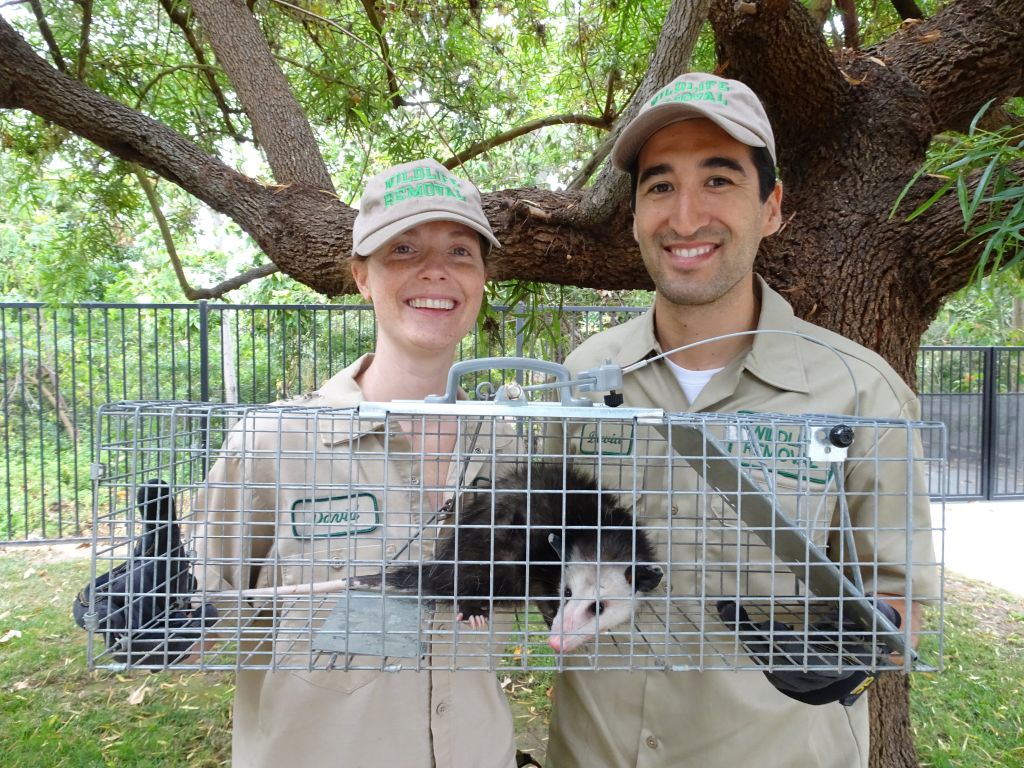
How To Remove Opossums Under A Shed?
You should be concerned if you ever spot an opossum near your home because these marsupials are very problematic. They carry lots of different diseases and can spread fleas and other parasites to your pets. Opossums also leave their droppings around your home, and nobody wants to deal with that.
Opossum Removal
If you want to get rid of the opossums under your porch, then have no fear. There are many methods you could try to use; some more effective than others.
- Live traps. Trapping opossums is a great approach. It’s humane and very effective. You should buy a live trap (also called a cage trap) and place it near the shed along the animals’ path. To make the trap more effective, try adding fruits and vegetables like apples and bananas. Once you catch the animal, you can relocate it far away from your home and release it back into the wild.
- Shooting. If you aren’t in the mood to buy traps and place them nearby, you might be tempted to simply shoot any opossums you see in your home. The biggest issue with this method is that opossums are protected in many areas, so you should check with local authorities before you try to kill these animals.
- Repellents. You could also try to repel opossums with some common deterrents like predator urine, moth balls, and ammonia. Unfortunately, opossums quickly grow used to these smells, so this method is not effective.
- Exclusion. Exclusion is another good approach to opossum removal. With this method, you start off by sealing all paths leading under you shed, except for one. You then place an exclusion door over that last opening. This allows opossums to leave the area under the shed but blocks them from getting back inside. Before you know it, all the opossums will have left.
- Professional Help. Trapping or excluding opossums is difficult, especially if you’ve never done it before. That’s why you should contact a professional wildlife removal company to take care of the problem for you. Their technicians will quickly get rid of those marsupials for you.
Opossum Prevention
Opossum removal is all well and good, but other wild animals will quickly replace them if you don’t take preventative measures. Here are some things you could do to keep out opossums and other wildlife.
- Remove food sources. The main reason animals enter your home or shed is because of food, so you can reduce the appeal by removing some of these food sources. Make sure you secure your garbage can to stop them from rummaging through it. You should also pick fruits and vegetables growing in your garden before opossums can get to them.
- Seal all openings. Opossums get under your shed through some openings. You should take the time to examine it and find all these entries. Then seal them with wire mesh or other material.
- Install a fence. A fence is a great first line of defense, so you should build one around your home. Make sure it’s at least 3 to 4 feet above the ground and at least 1 foot underground, as this stops opossums from climbing over or digging under it. The top of the fence should also be pointed outwards to make it more difficult for these animals to climb.
Once you’ve taken these steps, your shed should be opossum-free and it should stop future wildlife infestations.
